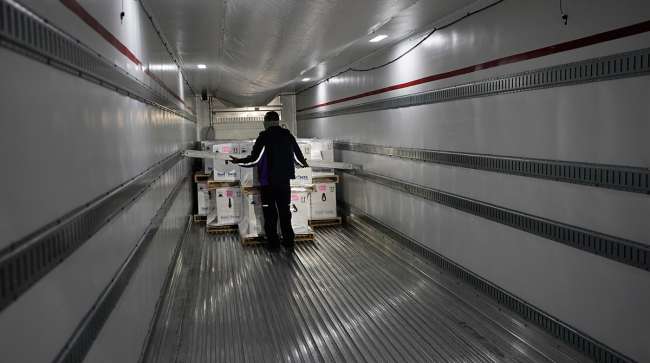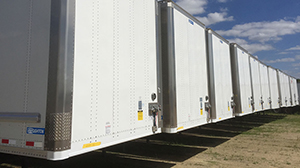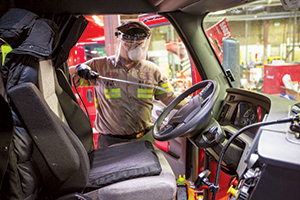Senior Reporter
Year in Review: Trucking Emerges Strong After Challenging 2020

[Stay on top of transportation news: Get TTNews in your inbox.]
Trucking emerged from one of the most challenging years on record strong and battle-tested, as robust freight demand propelled by soaring demand for consumer goods amid the coronavirus pandemic boosted spot rates and lifted financial results for many publicly traded fleets.
The arrival of the first preventative COVID-19 vaccine in December brought with it a sense the return to normalcy was within sight.
It marked an optimistic close to an unexpected, difficult year.

Uncertainty affected trailer orders. (Stoughton Trailers)
Truck makers, trailer makers, suppliers, fleets and other logistics providers worked to limit the spread of the novel coronavirus pandemic in their spaces to protect employee health and safety. They deployed protocols like remote work, where possible, and social distancing. Fleets cleaned their trucks and facilities even more vigorously than normal and ensured drivers and staff had cleaning supplies and masks.
Still, the disruptive virus would not spare industry suppliers.
“In February, we were coming off an all-time record unit year in 2019, and still going flat-out,” said Craig Bennett, senior vice president at Utility Trailer Manufacturing Co. “Then in March the bottom fell out, and numerous orders were canceled and delayed. We furloughed or laid off around 1,100 people and reassigned all other teams.”
About 70% of those employees have since been rehired, and new employees were trained and added, he said. Utility is America’s oldest privately owned, family-operated trailer manufacturer.
Amid the uncertainty, industry trailer orders plunged to an all-time low of 209 in April. Class 8 orders sank that same month to 4,251 compared with 14,859 a year earlier. But Class 8 sales were largely consistent throughout the year, as fleets methodically added trucks, mostly for replacement.
- The year's Top 10 stories
- The year in charts
- Stories: Business | Government
- Video: Business | Tech | Government
- Podcast: Part One | Part Two
Truckers achieved heroic status, delivering freight to restock bare shelves or deliver hygienic supplies and other vital goods during the earliest days of the novel coronavirus’ sweep across the country. Financially, truckload carriers were the key beneficiaries, said Satish Jindel, founder of SJ Consulting Group. The publicly traded less-than-truckload carriers — reliant on retail, or heavier industrial, automotive and chemical shipments — during the second quarter saw shipments decline, collectively, 16% year-over-year, with a revenue dip of 17.9%.
“The pandemic effect on LTLs was significant,” he said.
The industry broadly felt the long-term effects of the downturn, but American Trucking Associations chief economist Bob Costello in June noted that underlying business considerations were not to blame. “It was a health crisis that morphed,” he said. “We have to get solutions to the health issues for trucking to come out of this completely.”
Costello added, “Eventually, the economy is going to grow at a really strong clip to historic highs.”

A worker at C.R. England sanitizes a truck to help protect the company's drivers. (C.R. England)
Another analyst noted that federal assistance helped keep the economy moving.
“There are a lot of angles to the year, and we would be remiss if we did not mention the stimulus programs that made a dire situation less so,” said Kenny Vieth, president of ACT Research. “The CARES Act and the Paycheck Protection Program, as well as the Federal Reserve’s extraordinary monetary policy response, put a floor under the U.S. economy.”
The monthly for-hire truck tonnage index from ATA showed the year’s economic volatility.
The index in January climbed a modest 0.8% when measured against 2019, and February was up 2.6% year-over-year. March showed a 4.3% year-over-year improvement, even as the pandemic began to take hold.
Over the summer, the economy — in the grip of the pandemic — began to plummet steeply.
July tonnage was down 8.3% year-over-year and August showed an 8.9% decline. September showed a leveling off as year-over-year tonnage remained negative, down 2.7% compared with 2019, but improving when compared with the previous two months. By October, tonnage posted an 8.7% decline compared with the 2019 period.
At the nation’s ports, the first half of the year saw cargo volumes plunge, in some cases by double-digit numbers, when measured against 2019.
Our proposed 2021 Budget reflects the consequences of the unprecedented drop in volumes across the Port Authority’s facilities and the steep reduction in revenue due to the COVID-19 pandemic.
Visit https://t.co/5LsggPwDJY by Dec 10th to provide your comments. pic.twitter.com/Ym6WeM8TbY — Port Authority of NY & NJ. Wear a Face Covering. (@PANYNJ) December 9, 2020
The Port Authority of New York and New Jersey announced it was seeking $3 billion in federal aid because of lost revenue not only at the sprawling facility in the New York area, but also to help recoup money lost by the huge drop in airline passenger traffic at JFK, LaGuardia and Newark Liberty International airports, which the port authority manages.
But then came the surge. As the Asian economies began to reopen, U.S. retailers — anxious to restock warehouses and stores — needed inventory. Hundreds of thousands of containers carrying a wide variety of products ended up being sent to the big Atlantic and Pacific ports.
End-of-the-year volumes reached record or near-record levels at several facilities. With this surge came heavy congestion, and delays.
Retail buying patterns had shifted, too.
UPS Inc.-founded Ware2Go noted in a study Nov. 12 that 62% of consumers started their holiday shopping in October. The survey also found that 54% planned to do more shopping in 2020 than last year and 83% would shop online for more of their gifts.
A technological shift also continued with trucks, as work on truck electrification — and its emphasis on sustainability — pushed forward. So did testing of autonomous trucks. Two startups in the zero-emission space, Hyliion and Nikola, went public.

Mercedes-Benz GenH2 Truck by Daimler Truck AG
Daimler Truck AG and Volvo Group reached a binding agreement to commercialize fuel cell systems in heavy-duty vehicles by the second half of the decade, noting that the joint venture will decrease development costs for both companies and accelerate the market introduction of fuel cell systems.
Among states, California, New York and several others pushed for cleaner vehicles.
“Policies like clean vehicle standards set a level playing field for competition and promote innovation by manufacturers,” said Luke Tonachel, director of the clean energy and fuels group at the environmental group NRDC. “Corporations see viable [trucks] coming to market to fulfill their sustainability goals and set commitments that reinforce the market signal to manufacturers.” Calstart, a Pasadena, Calif.-based clean transportation accelerator, has been keeping a list of those equipment suppliers, he said, through its Drive to Zero program.
“We have seen significant growth in at least companies making more goals about what they want to do to reduce social and environmental impact,” said Alexis Bateman, director of sustainable supply chain at MIT Center for Transportation & Logistics.
“When you get into the next step about how they are achieving it and reporting it, the results get a little murkier,” she said in October.
Knight-Swift Transportation Holdings Inc., North America’s largest truckload carrier, announced a goal to cut its carbon emissions in half by 2035.
U.S. average on-highway #diesel fuel price on 12/14/2020 was $2.559/gal, UP 3.3¢/gallon from 12/07/2020, DOWN 48.7¢/gallon from year ago https://t.co/tvkdMilKAf #truckers #shippers #fuelprices pic.twitter.com/IePESSYWZ0 — EIA (@EIAgov) December 15, 2020
For now, however, diesel remains king of fuels. And fleets found diesel fuel prices, as reported by the Department of Energy, improved as 2020 went along. The U.S. average price per gallon fell from $3.079 per gallon in January to $2.559 in mid-December.
That overall glide path was interrupted by modest increases in July and August, compared with the previous months. Those summer prices of about $2.43 held until late November when they climbed to slightly more than $2.50.
According to industry analyst Phil Flynn, oil prices increased late in the year amid hopes that a rollout of COVID-19 vaccines would lift global fuel demand.
“We’re seeing a rebound in demand, and refiners have been tightening the supply,” said Flynn, who is based in Chicago. “The refiners had to work off a lot of diesel supply, and they have done all they can to draw down those inventories because there’s been a glut. We’re also seeing demand here in the U.S. and China start to go through the roof again.”
That’s a far cry from the early days of 2020, before the effects of the pandemic reached U.S. shores.
“The reality is that, at first, there was not much attention paid to it,” said Truckload Carriers Association president John Lyboldt, who noted that when he arrived in March at his group’s annual meeting in Orlando, there only were small news stories about a virus breaking out in China.
“But after a week, COVID-19 became the buzzword and we were grateful to have concluded a successful event just before the virus grew into the global pandemic that it became,” he told Transport Topics.

Fuller
Business relationships had to change, and the trucking industry responded with renewed collaboration, said Mike Roeth, executive director of the North American Council for Freight Efficiency.
Contact was digital, often distant, through online services, but the work was completed, he said.
“I am so proud of how this industry continued its great collaborative work during this pandemic,” Roeth said. “It is just extraordinary and a testament to this industry and our ability to get things done.”
Eric Fuller, CEO of U.S. Xpress Enterprises Inc., put it succinctly: “2020 has spotlighted our most important asset — drivers.”
Want more news? Listen to today's daily briefing:
Subscribe: Apple Podcasts | Spotify | Amazon Alexa | Google Assistant | More


